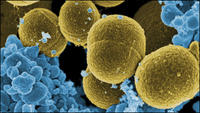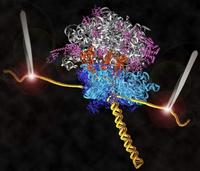-
Superbugs discovered to be breeding in sewage plants

Rice University study finds that two wastewater treatment plants in China fail to kill antibiotic-resistant bacteria. The bacteria were not only escaping purification but also breeding and spreading their dangerous cargo.
-
-
New weapon in the war on superbugs
In the arms race between bacteria and modern medicine, bacteria have gained an edge. In recent decades, bacterial resistance to antibiotics has developed faster than the production of new antibiotics, making bacterial infections increasingly difficult to treat. Scientists worry that a particularly virulent and deadly “superbug” could one day join the ranks of existing untreatable bacteria, causing a public health catastrophe comparable with the Black Death.
-
-
1950s pandemic flu virus still a health threat today, particularly to those under 50

Scientists have evidence that descendants of the H2N2 avian influenza A virus that killed millions worldwide in the 1950s still pose a threat to human health, particularly to those under 50. The study included twenty-two H2N2 avian viruses collected from domestic poultry and wild aquatic birds between 1961 and 2008, making it the most comprehensive analysis yet of avian H2N2 viruses.
-
-
Malaria parasite circumvents natural defense
Researchers have discovered recent genetic mutations in a parasite that causes over 100 million cases of malaria annually — changes that may render tens of millions of Africans who had been considered resistant, susceptible to infection. The 3-gene mutations appear to be the parasite’s invasion mechanisms. The changes occur in the Plasmodium vivax genome, and the Malaria Atlas Project estimates 2.5 billion people worldwide are at risk for P. vivax malaria.
-
-
Holograms to help in fighting malaria
Scientists have developed a 3D filming technique that could inform research to stem the spread of malaria. Creating moving digital holograms of malaria sperm has given researchers fresh insights into the behavior of these tiny life forms. Understanding how malaria parasites mate could pave the way for improved prevention and control of this deadly disease, which poses a threat to half of the world’s population.
-
-
Quick ID for water pathogens

New research purports to help people stay healthy by developing a real-time water bug testing that could precisely identify the culprits responsible for waterborne disease.
-
-
Universal flu vaccine within sight
Researchers asked volunteers to donate blood samples just as the swine flu pandemic was getting underway and report any symptoms they experienced over the next two flu seasons. They found that those who avoided severe illness had more CD8 T cells, a type of virus-killing immune cell, in their blood at the start of the pandemic. The researchers believe a vaccine that stimulates the body to produce more of these cells could be effective at preventing flu viruses, including new strains that cross into humans from birds and pigs, from causing serious disease.
-
-
Untreatable: the growing menace of drug-resistant health threats
Every year, more than two million people in the United States get infections which are resistant to antibiotics and at least 23,000 people die as a result, according to a new report issued by the Centers for Disease Control and Prevention. A new report ranks threats, outlines four core actions to halt resistance.
-
-
Killing superbugs dead

The overuse of antibiotics has created strains of bacteria resistant to medication, making the diseases they cause difficult to treat, or even deadly. Now, however, researchers have identified a weakness in at least one superbug that scientists may be able to medically exploit.
-
-
Designer bacteria show way for better vaccines
Researchers have developed a menu of sixty-one new strains of genetically engineered bacteria that may improve the efficacy of vaccines for diseases such as flu, pertussis, cholera, and HPV. The strains are part of a new class of biological “adjuvants” that is poised to transform vaccine design. Adjuvants are substances added to vaccines to boost the human immune response.
-
-
New way to design vaccines: modifying antibodies to trigger immune response
In an approach with the potential to aid therapeutic vaccine development, scientists have shown that enzymatically modified antibodies can be used to generate highly targeted, potent responses from cells of the immune system
-
-
Pigs in southern China found to be infected with avian flu

Researchers report for the first time the seroprevalence of three strains of avian influenza viruses in pigs in southern China, but not the H5N1 avian influenza virus; their research has implications for efforts to protect the public health from pandemics
-
-
Rinderpest: how the world’s deadliest cattle plague was eradicated
Rinderpest, the deadliest of cattle diseases, was declared vanquished in May 2011; after smallpox, it is only the second disease (and first livestock disease) ever to be eradicated from the earth; the insights gained from the eradication campaign may be applied to similar diseases that today ravage the livestock populations on which the livelihoods of one billion of the world’s poor depend; the lessons could also be applied to “zoonotic” diseases which are responsible for 2.4 billion cases of human illness and 2.2 million deaths per year
-
-
New synthesis devised for most useful, yet expensive, antimalarial drug
In 2010 malaria caused an estimated 665,000 deaths, mostly among African children; now, chemists have developed a new synthesis for the world’s most useful antimalarial drug, artemisinin, giving hope that fully synthetic artemisinin may help reduce the cost of the live-saving drug in the future
-
-
Near-instantaneous DNA analysis
Polymerase chain reaction (PCR) is an indispensible technique allowing researchers and clinicians to produce millions of copies from a single piece of DNA or RNA for use in genome sequencing, gene analysis, inheritable disease diagnosis, paternity testing, forensic identification, and the detection of infectious diseases; PCR for point-of-care, emergency-response, or widespread monitoring applications needs to be very fast — on the order of a few minutes; this has now been achieved
-
- All
- Regional
- Water
- Biometrics
- Borders/Immig
- Business
- Cybersecurity
- Detection
- Disasters
- Government
- Infrastructure
- International
- Public health
- Public Safety
- Communication interoperabillity
- Emergency services
- Emergency medical services
- Fire
- First response
- IEDs
- Law Enforcement
- Law Enforcement Technology
- Military technology
- Nonlethal weapons
- Nuclear weapons
- Personal protection equipment
- Police
- Notification /alert systems
- Situational awareness
- Weapons systems
- Sci-Tech
- Sector Reports
- Surveillance
- Transportation
Advertising & Marketing: advertise@newswirepubs.com
Editorial: editor@newswirepubs.com
General: info@newswirepubs.com
2010-2011 © News Wire Publications, LLC News Wire Publications, LLC
220 Old Country Road | Suite 200 | Mineola | New York | 11501
Permissions and Policies
Editorial: editor@newswirepubs.com
General: info@newswirepubs.com
2010-2011 © News Wire Publications, LLC News Wire Publications, LLC
220 Old Country Road | Suite 200 | Mineola | New York | 11501
Permissions and Policies
